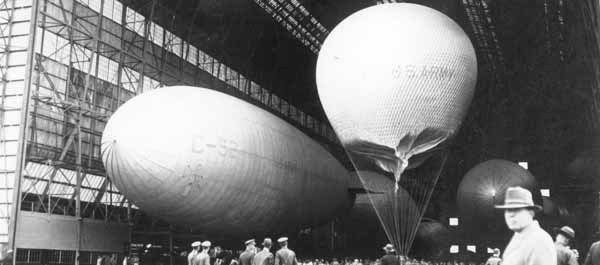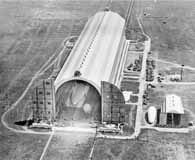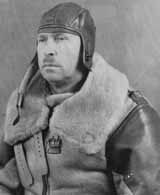Journey To Obsolescence: The Army Air Corps Lighter-Than-Air Branch – Part 1

The arrival of the 20th century brought with it an explosion of progress greater than that ever experienced by mankind in previous centuries. Our nation, along with much of the rest of the world, was to transform from an agricultural based economy to an industrial society with large metropolitan cities that became connected by new transportation innovations such as railroad trains, automobiles, paved highways, and communications capabilities including telephones, and radios.
One of the most exciting new horizons that opened was that of the flying machine which, although dreamed of for hundreds of years by far-sighted visionaries, only became possible when the combustion engine could be fitted on a frame capable of sustained flight in the air. Men such as Samuel Langley and Orville and Wilber Wright were early pioneers in developing such a flying machine, a heavier-than-air vehicle. However, there were other adventurous souls that faced the same challenge and came up with another solution, that being the use of lighter-than- air (LTA) ships, held aloft by gaseous substances such as hydrogen or helium that would be capable of transporting men and material. Balloons were not a new idea as the 20th century dawned, but the advent of the combustible engine made them an attractive alternative to the much more complicated heavier-than-air option. The U.S. military had previously experimented with tethered balloons in the Civil War (both sides) and in the War with Spain in 1898, mainly using the floating objects as a platform to gain intelligence on the battlefield.
{default}Early on in the Century, the pioneers of the air recognized the potential value of a flying machine during armed combat. Thus, it was natural that it was to the military forces they turned for financial support and as a possible revenue source for the future. One of the earliest Army Aviators was Lieutenant Frank Lahm, West Point Class of 1901, who learned to fly in the Wright brothers’ first military airplane. Lahm also became a balloon pilot in 1905 and a dirigible (airship) pilot in 1908. Captain Charles de F. Chandler was another early aviation pioneer in lighter-than-air. His interest in balloon flight was sparked by a visit he made to British balloon facilities in Farnborough in 1905. By 1908 he had qualified as a balloon pilot and in subsequent years participated in cross country free balloon flights. On one of these, a flight of four and a half hours, he was accompanied by former President Theodore Roosevelt.
 The first U.S. officer to qualify as a lighter-than airship pilot was Benjamin Foulois (1908) who, like Chandler, also learned to fly with the Wright brothers in their 1909 Flyer. Foulois would later become Chief of the Army Air Corps in 1931-1935. Lt. Thomas Selfridge, West Point Class of 1903, was the first U.S. military officer to pilot a heavier-than-air machine in May of 1908. In August of that same year, he received his dirigible and balloon certificate. Then, in September, he unfortunately became the first member of the military to be killed as a result of an aircraft accident when he was a passenger on the “Wright Flyer” at Fort Myer, Virginia.
The first U.S. officer to qualify as a lighter-than airship pilot was Benjamin Foulois (1908) who, like Chandler, also learned to fly with the Wright brothers in their 1909 Flyer. Foulois would later become Chief of the Army Air Corps in 1931-1935. Lt. Thomas Selfridge, West Point Class of 1903, was the first U.S. military officer to pilot a heavier-than-air machine in May of 1908. In August of that same year, he received his dirigible and balloon certificate. Then, in September, he unfortunately became the first member of the military to be killed as a result of an aircraft accident when he was a passenger on the “Wright Flyer” at Fort Myer, Virginia.
It was Charles Chandler who became the first commander of the Army Balloon School at Fort Omaha in 1908. The Army opened this school to develop pilots, tactics and doctrine for this new addition to its inventory of equipment that would be used to fight the wars of the new century. However, due to a shortage of money, the school was closed in 1913 and Chandler was sent off to the Philippines. He returned to Omaha in 1916 to reopen the school and provide training for individuals and units that would soon be fighting in World War I. In October of the following year, now a Colonel, Chandler sailed for France to become the head of the Balloon Section, American Expeditionary Forces.
When the United States entered World War I, the Army balloon force consisted of eight officers and sixty enlisted men. The Army Staff developed a plan to expand the Balloon Corps into 69 companies of 90 men and 8 officers each. By the time the war ended in November 1918, 110 companies had been organized and 35 were in the war zone in Europe. Chandler’s force was divided into two wings. Each wing was composed of 15 companies. One wing was commanded by Lt. Colonel John Paegelow, a seasoned officer who had been born in Germany, graduated with an engineering degree from Heidelberg University, and served one year in the German Army before immigrating to the United States. Once here, he enlisted in the Army and served in the Spanish-American War. After winning a commission as a 1st Lieutenant, he was sent to the Philippines. While stationed there, he negotiated with a rebel leader on the island of Luzon the surrender of over a thousand insurgents, an individual accomplishment that earned him an invitation to attend the inauguration of President Theodore Roosevelt. Returning to the Philippines, he became the Military Governor of Mindanao and became a close friend of future General of the Armies, John J. Pershing. Transferring to the Army Air Service, he returned to Fort Omaha. There he earned his balloon pilot’s license. The second wing was under the command of a relatively junior officer, Major John Jouett, a West Point graduate from the Class of 1914, who had earned his balloon certificate from the Omaha Lighter-Than-Air School in 1917.
In the First World War, the Balloon companies were officially a part of the Army Signal Corps, mainly because, early on, the Army had recognized the value of these new craft to enhance communications capabilities. However, as the units arrived in Europe, they were soon to find out that they would be operating in missions other than communication relay stations. From the experiences of their principal allies, namely the French, British, and Italians, and even from their main adversaries, the Germans, the Americans soon learned that observers located in balloons operating in battle areas could serve as Artillery forward observers with much better results than observers adjusting massed fires from ground level positions.
 Far more powerful and accurate artillery projectiles were developed early on in the 1914-1918 war and the concentrations and volume of such fire played an increasingly important role in the war on the Western Front as the fighting stalemated into a trench war standoff. The balloons used by the American Balloon Companies were tethered balloons filled with hydrogen. Unfortunately, the hydrogen was highly flammable and made the balloons sitting duck targets for attacks by some ground weapons as well as enemy aircraft. To protect the balloon from ground fire, they were usually flown from 2000 to 7000 yards back from the front lines and at an altitude of 3500 feet or more. Each Balloon company had a battery of twelve machine guns which were emplaced in the vicinity of the balloon to protect it from attack by enemy aircraft. Balloons were usually spaced five miles apart along the front. They were anchored to a winch that was attached to a motor car. Observers in the balloons reported being able to see activity on the ground at a distance up to 15 miles or more along the front. They were routinely connected by telephone to Corps headquarters, artillery firing units, and even to other balloons in their sector. Since airplanes in those days were not able to communicate well with the troops on the ground, the balloon observers were capable of providing more timely information on both friendly and enemy locations and activities, allowing them to become a very valuable asset in the fighting.
Far more powerful and accurate artillery projectiles were developed early on in the 1914-1918 war and the concentrations and volume of such fire played an increasingly important role in the war on the Western Front as the fighting stalemated into a trench war standoff. The balloons used by the American Balloon Companies were tethered balloons filled with hydrogen. Unfortunately, the hydrogen was highly flammable and made the balloons sitting duck targets for attacks by some ground weapons as well as enemy aircraft. To protect the balloon from ground fire, they were usually flown from 2000 to 7000 yards back from the front lines and at an altitude of 3500 feet or more. Each Balloon company had a battery of twelve machine guns which were emplaced in the vicinity of the balloon to protect it from attack by enemy aircraft. Balloons were usually spaced five miles apart along the front. They were anchored to a winch that was attached to a motor car. Observers in the balloons reported being able to see activity on the ground at a distance up to 15 miles or more along the front. They were routinely connected by telephone to Corps headquarters, artillery firing units, and even to other balloons in their sector. Since airplanes in those days were not able to communicate well with the troops on the ground, the balloon observers were capable of providing more timely information on both friendly and enemy locations and activities, allowing them to become a very valuable asset in the fighting.
An amazing statistic is that in the many months that the American Expeditionary Force was involved in combat in WW I, only one balloon crewman lost his life. Two were captured by the Germans when their balloon broke away from its mooring winch and floated over enemy positions. Twelve U. S. balloons were destroyed by enemy action and 35 more caught fire and burned, but all crewmembers except the one KIA were able to survive the experience. Most escaped by parachute. One unfortunate but persistent balloon pilot found it necessary to exit three different balloons by parachute in one day’s fighting.
When the war ended in November of 1918, the LTA Service had established a solid reputation as an integral part of the U. S. Army battlefield forces. However, outside of the military, they received little public recognition. The glamorous part of air combat had been monopolized by those that flew heavier-than-air machines, especially famed aces like Germany’s Manfred von Richthofen and America’s Eddie Rickenbacker. But those who had served in the balloon units, men such as Charles Chandler and John Paegelow, certainly must have felt they too were part of a new future force that would become a major multiplier of military combat power.
The story continues in Part 2.
Major General, ret. Neal Creighton, whose distinguished military career included command of the U. S. 1st “Big Red One” Infantry Division, is the author of “A Different Path: The Story of an Army Family” (Xlibris, 2008).


I visited one of the last remaining airship hangers at Tillamook, Oregon. Blimps were extensively used as sub spotters off of the East and West coasts during WWII.